一般现在时间,一般过去时被动语态
动词时态和被动语态
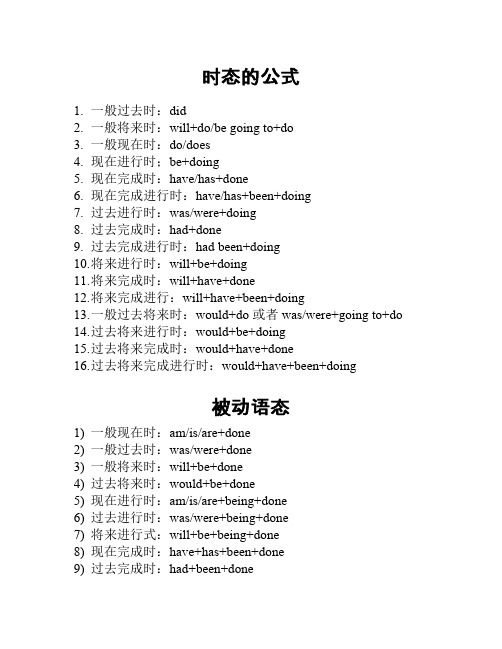
时态的公式
1.一般过去时:did
2.一般将来时:will+do/be going to+do
3.一般现在时:do/does
4.现在进行时;be+doing
5.现在完成时:have/has+done
6.现在完成进行时:have/has+been+doing
7.过去进行时:was/were+doing
8.过去完成时:had+done
9.过去完成进行时:had been+doing
10.将来进行时:will+be+doing
11.将来完成时:will+have+done
12.将来完成进行:will+have+been+doing
13.一般过去将来时:would+do或者was/were+going to+do
14.过去将来进行时:would+be+doing
15.过去将来完成时:would+have+done
16.过去将来完成进行时:would+have+been+doing
被动语态
1)一般现在时:am/is/are+done
2)一般过去时:was/were+done
3)一般将来时:will+be+done
4)过去将来时:would+be+done
5)现在进行时:am/is/are+being+done
6)过去进行时:was/were+being+done
7)将来进行式:will+be+being+done
8)现在完成时:have+has+been+done
9)过去完成时:had+been+done
10)将来完成时:will+have+been+done。
一般现在时和一般过去时的被动语态
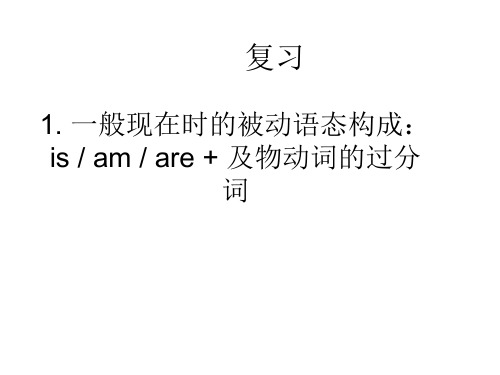
5. Last year we built a library in our
school. A library __w__a_s__ __b_u_i_lt__ in our school last year.
7. Did you plant many trees at this time last year?
__W__er_e__ __m_a_n_y_ __t_r_e_e_s_ _p_l_a_n_t_ed_ at this time last time?
9. The foreign friends gave us some wonderful stamps. 1) __w_e____ __w_e_r_e_ __g_i_v_e_n_ some wonderful stamps.
复习
1. 一般现在时的被动语态构成: is / am / are + 及物动词的过分
词
练习
They do their homework after school.
He plays basketball every week.
My mother sweeps the floor every day.
invent
Thomas Edison invented the light. The light was invented by Thomas Edison .
练习
1.They had an evening party last week.
2,The students planted many trees yesterday
2) Some wonderful stamps __w__e_re__ __g_iv_e_n___ _t_o_____ _u_s_____.
被动语态的用法归纳时态
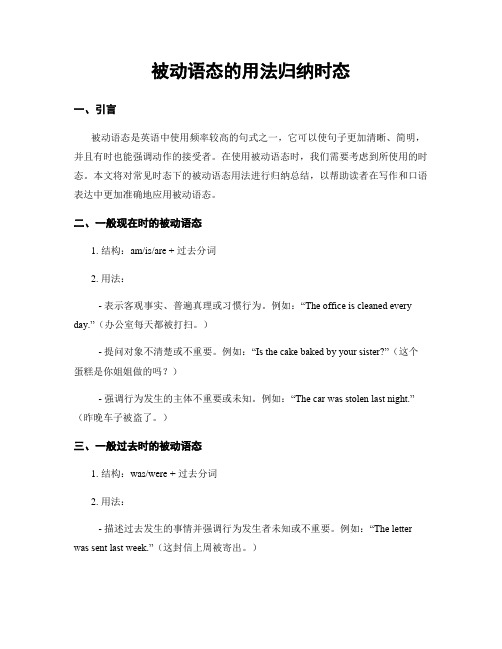
被动语态的用法归纳时态一、引言被动语态是英语中使用频率较高的句式之一,它可以使句子更加清晰、简明,并且有时也能强调动作的接受者。
在使用被动语态时,我们需要考虑到所使用的时态。
本文将对常见时态下的被动语态用法进行归纳总结,以帮助读者在写作和口语表达中更加准确地应用被动语态。
二、一般现在时的被动语态1. 结构:am/is/are + 过去分词2. 用法:- 表示客观事实、普遍真理或习惯行为。
例如:“The office is cleaned every day.”(办公室每天都被打扫。
)- 提问对象不清楚或不重要。
例如:“Is the cake baked by your sister?”(这个蛋糕是你姐姐做的吗?)- 强调行为发生的主体不重要或未知。
例如:“The car was stolen last night.”(昨晚车子被盗了。
)三、一般过去时的被动语态1. 结构:was/were + 过去分词2. 用法:- 描述过去发生的事情并强调行为发生者未知或不重要。
例如:“The letter was sent last week.”(这封信上周被寄出。
)- 用于报道、新闻等动作的客观描述。
例如:“The building was destroyed in the fire.”(楼房在火灾中被摧毁了。
)四、一般将来时的被动语态1. 结构:will be + 过去分词2. 用法:- 表示计划、安排或预测中的动作。
例如:“The project will be completed next month.”(这个项目将于下个月完成。
)- 提问对象不明确,但是对方会进行某种行动,只是具体行为未知。
例如:“Will the job offer be accepted?”(这份工作提议会被接受吗?)五、现在进行时的被动语态1. 结构:am/is/are being + 过去分词2. 用法:- 描述正在进行或即将发生的行为,并强调动作接受者或让步状语从句后半部分的内容。
五种常用时态的被动语态
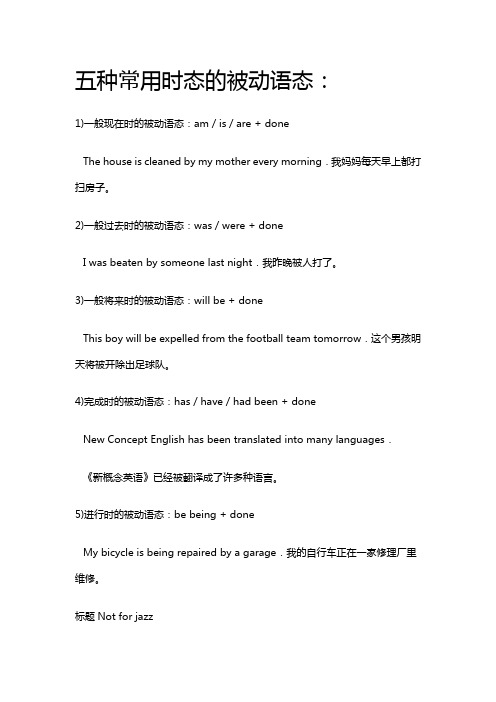
五种常用时态的被动语态:1)一般现在时的被动语态:am/is/are + doneThe house is cleaned by my mother every morning.我妈妈每天早上都打扫房子。
2)一般过去时的被动语态:was/were + doneI was beaten by someone last night.我昨晚被人打了。
3)一般将来时的被动语态:will be + doneThis boy will be expelled from the football team tomorrow.这个男孩明天将被开除出足球队。
4)完成时的被动语态:has/have/had been + doneNew Concept English has been translated into many languages.《新概念英语》已经被翻译成了许多种语言。
5)进行时的被动语态:be being + doneMy bicycle is being repaired by a garage.我的自行车正在一家修理厂里维修。
标题Not for jazz总结for的用法:1)为:I bought a book for you.我为你买了一本书。
2)因为:Something fell in,for I heard a splash.一定有东西掉下去了,因为我听见扑通一声。
4)适合:Not for jazz=It's not suitable to play jazz on the clavichord.古钢琴不适合演奏爵士乐。
Question:What happened to the clavichord?to后面加宾语,表示其身上发生了什么事,即动作的目标、对象。
What happened to you?你怎么了?(在你身上发生了什么事?)(1)否定句与疑问句的被动语态We don’t believe her.我们不信她的话。
一般现在时、一般过去时、一般将来时被动语态讲解及练习(无答案)
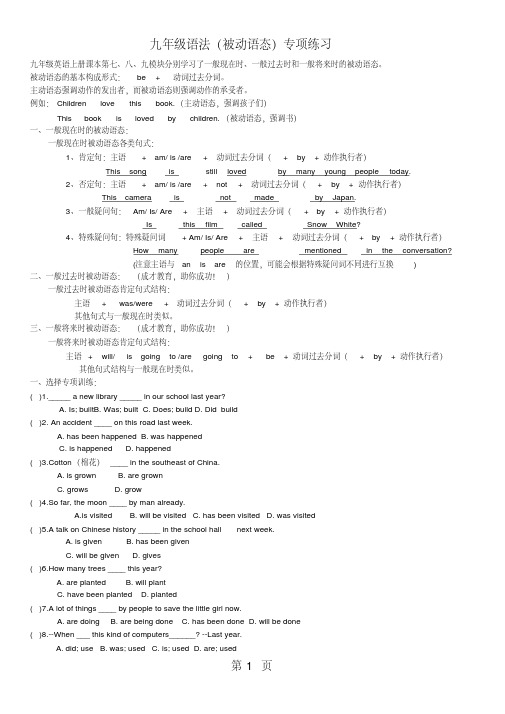
九年级语法(被动语态)专项练习九年级英语上册课本第七、八、九模块分别学习了一般现在时、一般过去时和一般将来时的被动语态。
被动语态的基本构成形式:be + 动词过去分词。
主动语态强调动作的发出者,而被动语态则强调动作的承受者。
例如:Children love this book.(主动语态,强调孩子们)This book is loved by children.(被动语态,强调书)一、一般现在时的被动语态:一般现在时被动语态各类句式:1、肯定句:主语+ am/ is /are + 动词过去分词(+ by + 动作执行者)This song is still loved by many young people today.2、否定句:主语+ am/ is /are + not + 动词过去分词(+ by + 动作执行者)This camera is not made by Japan.3、一般疑问句:Am/ Is/ Are + 主语+ 动词过去分词(+ by + 动作执行者)Is this film called Snow White?4、特殊疑问句:特殊疑问词+ Am/ Is/ Are + 主语+ 动词过去分词(+ by + 动作执行者)How many people are mentioned in the conversation?(注意主语与an is are 的位置,可能会根据特殊疑问词不同进行互换)二、一般过去时被动语态:(成才教育,助你成功!)一般过去时被动语态肯定句式结构:主语+ was/were + 动词过去分词(+ by + 动作执行者)其他句式与一般现在时类似。
三、一般将来时被动语态:(成才教育,助你成功!)一般将来时被动语态肯定句式结构:主语+ will/ is going to /are going to + be + 动词过去分词(+ by + 动作执行者)其他句式结构与一般现在时类似。
各种时态的被动语态

各种时态的被动语态一、八大时态的被动语态的构成:1.一般现在时的被动语态构成:(am/is/are +done)如:I am asked to study hard. 我被请求努力学习。
This shirt is washed once a week. 这件T恤一周洗一次。
These songs are usually sung by boys. 这些歌曲通常是男生唱的。
2.一般过去时的被动语态构成:(was/were done)如:The soldier was killed, but the train was saved. 这位战士牺牲了,然而列车得救了。
Some notes were passed up to the speaker. 有人给讲演者递上来一些纸条。
3.一般将来时的被动语态构成:(shall/will be done)如:We shall be asked a lot of strange questions. 我们将被问许多怪题。
My son will be sent to school next September. 来年九月我将送我儿子去读书。
4.过去将来时的被动语态构成:(should/would be done)如:The news would be sent to him as soon as it arrived. 消息一到就会转给他的。
He told us that the new railway would be built the next year. 他告诉我新铁路将在明年修建。
5.现在完成时的被动语态构成:(has/have been done)如:The work has just been finished. 工作刚刚结束。
The old rules have been done away with by us. 旧规章已经被我们废除了。
6.过去完成时的被动语态构成:(had been done)如:By last December three ships had been built by them. 到去年十二月底他们已建造了三艘船。
各种时态的被动语态

各种时态的被动语态各种时态的被动语态一、八大时态的被动语态的构成:1.一般现在时的被动语态构成:(am/is/are +done)如:I am asked to study hard. 我被请求努力学习。
This shirt is washed once a week. 这件T恤一周洗一次。
These songs are usually sung by boys. 这些歌曲通常是男生唱的。
2.一般过去时的被动语态构成:(was/were done)如:The soldier was killed, but the train was saved. 这位战士牺牲了,然而列车得救了。
Some notes were passed up to the speaker. 有人给讲演者递上来一些纸条。
3.一般将来时的被动语态构成:(shall/will be done)如:We shall be asked a lot of strange questions. 我们将被问许多怪题。
My son will be sent to school next September. 来年九月我将送我儿子去读书。
4.过去将来时的被动语态构成:(should/would be done)如:The news would be sent to him as soon as it arrived. 消息一到就会转给他的。
He told us that the new railway would be built the next year. 他告诉我新铁路将在明年修建。
5.现在完成时的被动语态构成:(has/have been done)如:The work has just been finished. 工作刚刚结束。
The old rules have been done away with by us. 旧规章已经被我们废除了。
8种时态的被动语态

动词的语态:主动语态和被动语态被动语态的基本结构:Be + done(过去分词)1、一般现在时:(主动语态)I help you.发出者动词承受者变为被动语态:Do——am/is/are doneYou are helped by me.承受者谓语发出者2、一般过去时的被动:did——was/were done(I helped you.-每个例子可让学生自己先尝试变被动,再给答案)3、一般将来时的被动:Will do——will be done(I will help you.-)4、现在进行时的被动:Am/is/are doing ——Am/is/are being done(I am helping you.-)5、过去进行时的被动:Was/were doing——Was/were being done(I was helping you.-)6、现在完成时的被动:Have done——have been done (I have helped you.-)7、过去完成时的被动:Had done——had been done (I had helped you.-)8、过去将来时的被动:Would do ——would be done (I would help you.-)答案:2、You were helped by me.3、You will be helped by me.4、You are being helped by me.5、You were being helped by me.6、You have been helped by me.7、You had been helped by me.8、You would be helped by me.。
一般现在时和一般过去时被动语态的用法口诀
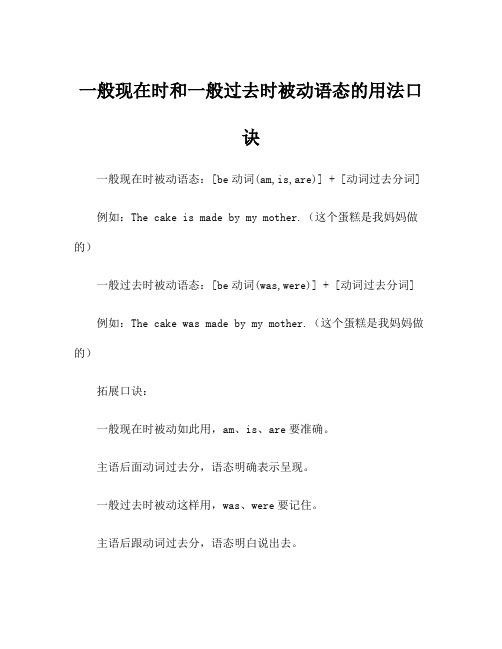
一般现在时和一般过去时被动语态的用法口
诀
一般现在时被动语态:[be动词(am,is,are)] + [动词过去分词] 例如:The cake is made by my mother.(这个蛋糕是我妈妈做的)
一般过去时被动语态:[be动词(was,were)] + [动词过去分词] 例如:The cake was made by my mother.(这个蛋糕是我妈妈做的)
拓展口诀:
一般现在时被动如此用,am、is、are要准确。
主语后面动词过去分,语态明确表示呈现。
一般过去时被动这样用,was、were要记住。
主语后跟动词过去分,语态明白说出去。
需要注意的是,一般现在时被动语态使用的是be动词
(am,is,are),一般过去时被动语态使用的是be动词(was,were),再加上动词的过去分词形式。
同时,被动语态表示的是动作的承受者,而不是执行者。
一般现在时与一般过去时的被动语态

常考的主动不带to,被动需要加上to 的动词短语
make sb do sth have sb do sth let sb do sth see sb do sth hear sb do sth watch sb do sth notice sb do sth
sb be made to do sth sb be had to do sth sb be let to do sth sb be seen to do sth sb be heard to do sth sb be watched to do sth sb be noticed to do sth
主语+谓语+宾人+ 宾物结构的被动语 态
1 He gives me an apple every day . 主 谓 宾人 宾物 时间状语
变被动宾人做主语 I am given an apple every day . (不需要添加任何
介词) 变被动宾物做主语
An apple is given to me every day (by him) . (需要根据动词短语的固定搭配添加合适的介
• eg. English is not studied (by us ) every day.
• c.疑问句:Is English studied (by us ) every day.?
• d.特殊疑问句:What/Where/When+ am / is / are +主语+动词的过去分词+ 其他?
1 My cousin bought a color TV set . 2.My brother mended his watch last night . 3.Mother made a big cake for us yesterday . 4.They painted the table green last week . 5.They found some money lying on the floor . 6.She showed me her new skirt .
五种常用时态的被动语态

五种常用时态的被动语态:1)一般现在时的被动语态:am/is/are + doneThe house is cleaned by my mother every morning.我妈妈每天早上都打扫房子。
2)一般过去时的被动语态:was/were + doneI was beaten by someone last night.我昨晚被人打了。
3)一般将来时的被动语态:will be + doneThis boy will be expelled from the football team tomorrow.这个男孩明天将被开除出足球队。
4)完成时的被动语态:has/have/had been + doneNew Concept English has been translated into many languages.《新概念英语》已经被翻译成了许多种语言。
5)进行时的被动语态:be being + doneMy bicycle is being repaired by a garage.我的自行车正在一家修理厂里维修。
标题Not for jazz总结for的用法:1)为:I bought a book for you.我为你买了一本书。
2)因为:Something fell in,for I heard a splash.一定有东西掉下去了,因为我听见扑通一声。
4)适合:Not for jazz=It's not suitable to play jazz on the clavichord.古钢琴不适合演奏爵士乐。
Question:What happened to the clavichord?to后面加宾语,表示其身上发生了什么事,即动作的目标、对象。
What happened to you?你怎么了?(在你身上发生了什么事?)(1)否定句与疑问句的被动语态We don’t believe her.我们不信她的话。
英语常见的动词时态和语态

英语常见的动词时态和语态时态是英语中表达时间和动作发生顺序的重要语法要素,而语态则用于表达主语和动作之间的关系。
掌握常见动词时态和语态的用法,对于提高英语语言的准确性和流利性至关重要。
本文将介绍英语中常见的动词时态和语态,包括一般现在时、一般过去时、一般将来时、现在进行时、过去进行时、将来进行时、现在完成时、过去完成时、将来完成时、一般过去将来时、过去完成将来时、被动语态等。
一般现在时(Simple Present Tense)一般现在时表示经常性、习惯性的动作或客观真理,也用于对现状的描述。
一般现在时的构成是主语+动词原形(第三人称单数要加s或es)。
例句:1. I play football every weekend.2. He reads a book every night.3. Water boils at 100 degrees Celsius.一般过去时(Simple Past Tense)一般过去时用于表达过去某个时间发生的动作或状态。
一般过去时的构成是主语+动词过去式。
例句:1. She studied English last night.2. They went to the park yesterday.3. The movie ended two hours ago.一般将来时(Simple Future Tense)一般将来时用于表示将来某个时间将要发生的动作或状态。
一般将来时的构成是主语+will+动词原形。
例句:1. I will travel to Japan next month.2. We will have a meeting tomorrow.3. She will call you later.现在进行时(Present Continuous Tense)现在进行时用于表示现在正在进行的动作。
现在进行时的构成是主语+is/am/are+动词-ing形式。
8种常用时态的被动语态

8种常用时态的被动语态由“助动词be + 动词的过去分词”构成。
助动词be 有时态、人称和数的变化。
(1) 一般现在时:am/is/are +过去分词。
如:Rice is grown in south China. 华南种植水稻。
(2) 一般过去时:was/were+过去分词。
如:The glass was broken yesterday. 这块玻璃是昨天打烂的。
(3) 现在进行时:am/is/are being +过去分词。
如:The project is being carried out. 这个计划正在执行中。
(4) 过去进行时:was/were/being +过去分词。
如:This road was being built this time last year. 这条路去年这个时候还在修建。
(5) 一般将来时:will be +过去分词。
如:The cars will be sent abroad by sea. 这些汽车将由水路运往国外。
(6) 过去将来时:would be +过去分词。
如:The manager said the project would be completed by the end of the year. 经理说这个工程在年底前将会完成。
(7) 现在完成时:have/has been +过去分词。
如:This novel has been translated into several languages. 这本小说已被译成了几种语言。
(8) 过去完在时:had been +过去分词。
如:When I got to the theatre, I found the tickets had already been sold out. 我到达剧院时,发现票已卖完了。
被动语态的主要用法■当不知道或没有必要指出动作的执行者时,常用被动语态,这时往往不用by短语。
高中英语十一种时态及被动

高中英语十一种时态及被动高中英语通常涵盖了十一种主要时态以及被动语态。
以下是这些时态及被动的简要介绍:1. 一般现在时(Simple Present Tense):用于描述经常性、习惯性或普遍真理。
例如:I play tennis every Sunday.2. 一般过去时(Simple Past Tense):用于描述过去发生的动作或状态。
例如:She danced at the party last night.3. 一般将来时(Simple Future Tense):用于表示将来发生的动作或计划。
例如:We will go to the beach next weekend.4. 现在进行时(Present Continuous Tense):用于描述正在进行的动作。
例如:They are studying for the exam.5. 过去进行时(Past Continuous Tense):用于描述过去某一时刻正在进行的动作。
例如:He was reading a book when I entered the room.6. 将来进行时(Future Continuous Tense):用于描述将来某一时刻正在进行的动作。
例如:At this time tomorrow, they will be having dinner.7. 现在完成时(Present Perfect Tense):用于描述过去发生的动作对现在的影响或与现在有关的经历。
例如:I have visited Paris.8. 过去完成时(Past Perfect Tense):用于描述过去某一时间点之前已经发生的动作。
例如:She had already left when I arrived.9. 将来完成时(Future Perfect Tense):用于描述将来某一时间点之前将会完成的动作。
例如:By next year, he will havegraduated.10. 现在完成进行时(Present Perfect Continuous Tense):用于描述从过去某一时刻开始,一直持续到现在的动作。
- 1、下载文档前请自行甄别文档内容的完整性,平台不提供额外的编辑、内容补充、找答案等附加服务。
- 2、"仅部分预览"的文档,不可在线预览部分如存在完整性等问题,可反馈申请退款(可完整预览的文档不适用该条件!)。
- 3、如文档侵犯您的权益,请联系客服反馈,我们会尽快为您处理(人工客服工作时间:9:00-18:30)。
一般现在时被动语态专练(一)
结构式:a.肯定句:主语+ am / is / are + 动词的过去分词 +(by+人代宾格 )+ 其他
eg .English is studied (by us ) every day.
b.否定句::主语+ am / is / are + not + 动词的过去分词
+(by+人代宾格 )+ 其他
eg. English is not studied (by us ) every day.
c.疑问句:Is English not studied (by us ) every day.
d.特殊疑问句:What/Where/When+ am / is / are +主语+动
词的过去分词+ 其他
一.把主动语态变成被动语态。
1.He cleans the room every Sunday.
2.Farmers grow rice in the south .
3.People in England speak English
4.We play football on the playground every afternoon.
5.Do you often watch TV at home in the evening
6.She doesn’t finish her homework
7.They don’t read that book.
8.Where do they watch basketball match every week
9.What does Tom study
10.When do you listen to music
二.把被动语态变成主动语态。
1.keys are used for locking .(we)
2.Football is played .(the students)
3.Desks are made of wood .(workers)
4.Chinese isn’t had in the classroom.(the teacher)
5.Is this book read every day
6.Where are bikes made (they)
7.What is done (Lucy)
8.Are the pens made in the factory(you )
9.English isn’t spoken by pe ople in China.
10.We are given some money (they).
一般过去时被动语态专练(二)
结构式:
a.肯定句:主语+ was /were+ 动词的过去分词 +(by+人代宾格 )+ 其
他
eg .English was studied (by us ) every day.
b.否定句:主语+ was /were+ not + 动词的过去分词 +(by+人代宾格 )+ 其他
eg. English was not studied (by us ) every day.
c.疑问句:Was English not studied (by us ) every day.
d.特殊疑问句:What/Where/When+was /were +主语+动词的过去分
词+ 其他
一.把主动语态变成被动语态
1.We built this library last year.
2.I watched TV yesterday evning.
3.He passed me a book .
4.She heard me sing in the next room .
5.The y didn’t finish his homework yesterday
6.Did you play football on the playground yesterday
7.Where did you fly a kite
8.When did they read this book
9.What did you use it for
10.He asked me not to go there.
二.被动语态变成主动语态。
baby was looked after by his mother .
he given any bananas( I )
were these bikes made by workers
wasn’t played on the playground .( the students ) heard to sing in the next room .(Tom)
tall building was built three years ago.(workers) your homework finished yesterday
weren’t made in the fac tory.(加主语)
9.When were those machines produced(we)
teachers weren’t listened to by the students .。
